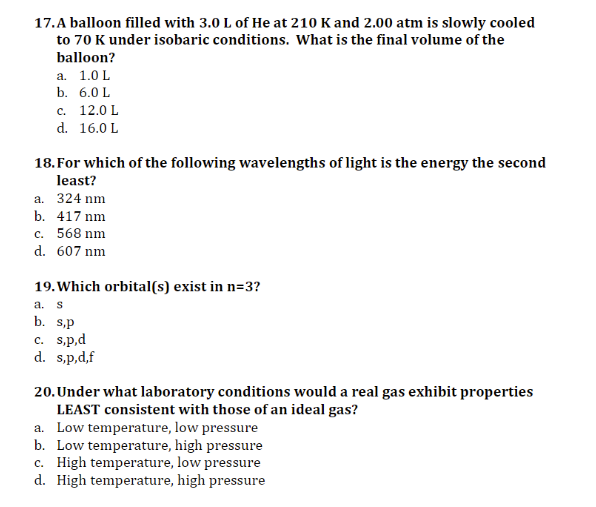17.A balloon filled with 3.0 L of He at 210 K and 2.00 atm is slowly cooled to 70 K under isobaric conditions. What is the final volume of the balloon? а. 1.0L b. 6.0 L c. 12.0 L d. 16.0 L
17.A balloon filled with 3.0 L of He at 210 K and 2.00 atm is slowly cooled to 70 K under isobaric conditions. What is the final volume of the balloon? а. 1.0L b. 6.0 L c. 12.0 L d. 16.0 L
Principles of Instrumental Analysis
7th Edition
ISBN:9781305577213
Author:Douglas A. Skoog, F. James Holler, Stanley R. Crouch
Publisher:Douglas A. Skoog, F. James Holler, Stanley R. Crouch
Chapter7: Components Of Optical Instruments
Section: Chapter Questions
Problem 7.3QAP: The Wien displacement law states that the wavelength maximum in micrometers for blackbody radiation...
Related questions
Question

Transcribed Image Text:17.A balloon filled with 3.0 L of He at 210 K and 2.00 atm is slowly cooled
to 70 K under isobaric conditions. What is the final volume of the
balloon?
а. 1.0L
b. 6.0 L
с. 12.0 L
d. 16.0 L
18. For which of the following wavelengths of light is the energy the second
least?
а. 324 nm
b. 417 nm
c. 568 nm
d. 607 nm
19. Which orbital(s) exist in n=3?
a. s
b. s,p
c. s.p,d
d. s,p,d,f
20. Under what laboratory conditions would a real gas exhibit properties
LEAST consistent with those of an ideal gas?
a. Low temperature, low pressure
b. Low temperature, high pressure
c. High temperature, low pressure
d. High temperature, high pressure
Expert Solution
This question has been solved!
Explore an expertly crafted, step-by-step solution for a thorough understanding of key concepts.
Step by step
Solved in 2 steps with 2 images

Knowledge Booster
Learn more about
Need a deep-dive on the concept behind this application? Look no further. Learn more about this topic, chemistry and related others by exploring similar questions and additional content below.Recommended textbooks for you

Principles of Instrumental Analysis
Chemistry
ISBN:
9781305577213
Author:
Douglas A. Skoog, F. James Holler, Stanley R. Crouch
Publisher:
Cengage Learning

Principles of Modern Chemistry
Chemistry
ISBN:
9781305079113
Author:
David W. Oxtoby, H. Pat Gillis, Laurie J. Butler
Publisher:
Cengage Learning

Physical Chemistry
Chemistry
ISBN:
9781133958437
Author:
Ball, David W. (david Warren), BAER, Tomas
Publisher:
Wadsworth Cengage Learning,

Principles of Instrumental Analysis
Chemistry
ISBN:
9781305577213
Author:
Douglas A. Skoog, F. James Holler, Stanley R. Crouch
Publisher:
Cengage Learning

Principles of Modern Chemistry
Chemistry
ISBN:
9781305079113
Author:
David W. Oxtoby, H. Pat Gillis, Laurie J. Butler
Publisher:
Cengage Learning

Physical Chemistry
Chemistry
ISBN:
9781133958437
Author:
Ball, David W. (david Warren), BAER, Tomas
Publisher:
Wadsworth Cengage Learning,

